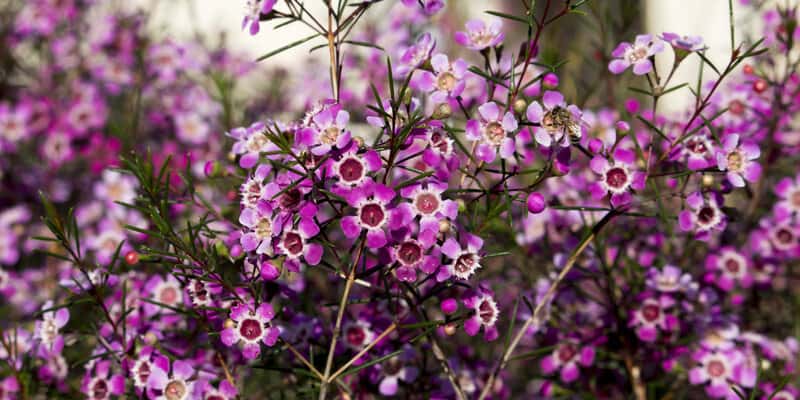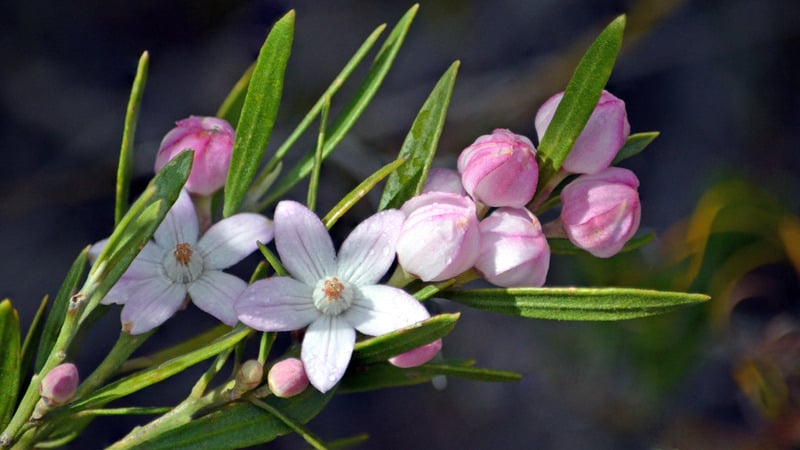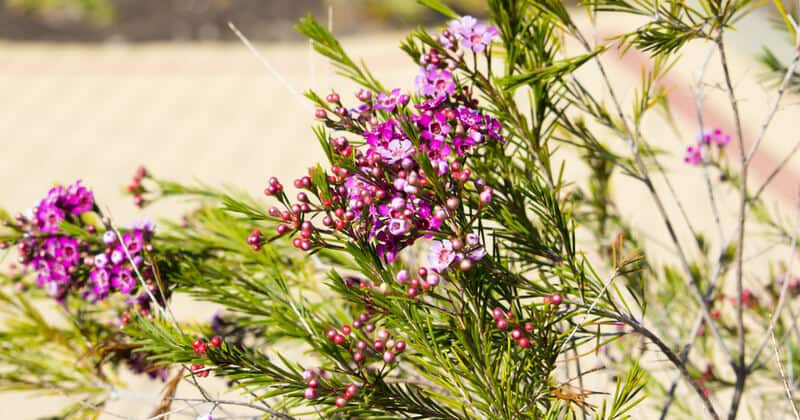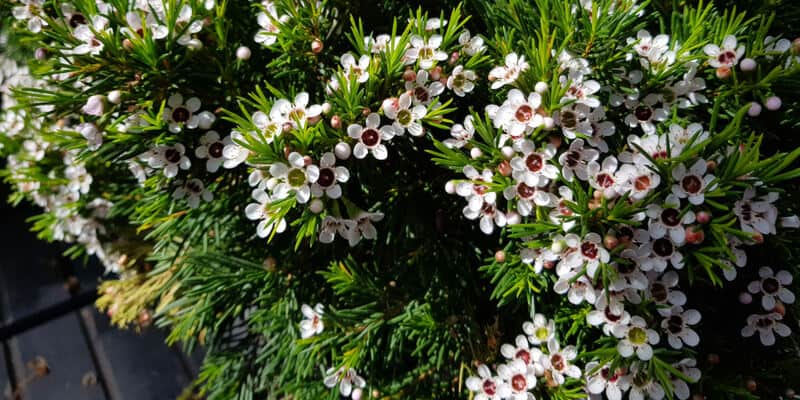Wax flowers – or waxflower plants, pick your spelling! – are woody, evergreen shrubs that start blooming in the dead of winter (unlike other Australian native flowers).
Their deep purple flowers add a pop of colour in the dreary season, all the way to late spring. They’re excellent for floral arrangements, and are a popular choice in the cut flower industry.
The wax flower is very low-maintenance, needing only light pruning and minimal moisture. It thrives in most conditions, but prefers sandy soil since it frequently grows along the coast.
Water well while it’s establishing, but mature plants are very drought tolerant. Still, water during the growing season to encourage flowers – and keep it somewhere with full sun!
If you want to grow waxflower plants in your garden – here’s your full care guide, from wax flower facts to how to grow waxflowers!
Wax Flower Facts
Wax flowers are native plants – specifically to Western Australia. These Australian plants are frost-hardy evergreen shrubs, which flower from late winter to early spring.
Waxflower plants (or the Chamelaucium species) are members of the Myrtle family. They’re very popular as cut flowers, since the blooms can last up to three weeks.
The wax flower is named for the waxy feel of its blooms. It has a whole shade range, from deep purple to pink to white flowers.
Types Of Wax Flowers

There are several varieties of Australian wax flowers:
- Geraldton Wax Flower: The most commonly cultivated wax flower, the Geraldton Wax is a favourite in native gardens for its pink flowers. It grows best in temperate climates, with full sun and well drained soil.
- Pink Waxflower: This variety can grow in partial shade, and blooms in clusters of delicate pink flowers. It can reach 2m in height and prefers sandy loam for soil. It’s easier to grow in a container than on a lawn.
- Benth: This is one of the smallest wax flower varieties, reaching just 1.3m. It grows in the Wheatbelt region of Western Australia, in sandy soils.
- Esperance Wax: The Esperance initially grows white flowers, but they turn pink and red as the plant matures. It prefers a sandy environment in the heathland, and can grow up to 2m in height.
- Large Waxflower: Also called Megalopetalum, this is one of the biggest types of waxflower plants, reaching a whopping 2.5m. Its flowers range from cream to pink.
NOTE: While the Hoya vine is indeed nicknamed the wax plant, it’s not actually a wax flower! It’s from the Apocynaceae family, and can mostly be found in Queensland. Meanwhile, the long-leaf waxflower is a Philotheca variety, and is endemic to the southeast. Confusing, we know!
Growing Wax Flower

Soil
Avoid poorly drained soils, as the wax flower cannot tolerate too much moisture.
It will grow in most conditions, but likes sandy loam soils best. You can top up the soil with organic mulch before planting.
Light
Waxflower plants like full sun, which helps them grow and bloom.
Some varieties, like the pink waxflower, can grow in partial shade.
Growing conditions
The wax flower likes dry conditions, so make sure not to overwater, and don’t keep them anywhere humid.
They can also thrive through the winter, and even start to bloom in the later months. They’ll tolerate drought well, so only water when the soil has dried out.
If you’re unsure about caring for your waxflower plants, get a local gardening service to help you out!
How To Grow Waxflower Plants

Waxflowers are best grown from seedlings or starter plants, so check with your local nursery to see which varieties they have in stock.
Choose a spot in your garden that gets full sun to partial shade. Make sure your soil drains well – mix with sand if needed!
Dig a planting hole that’s the same depth as the root ball, and twice as wide.
Gently remove the plant from its container. Try not to disturb the roots – waxflowers are sensitive!
Position your plant inside the hole and carefully backfill with soil. Firm down to keep the plant in place.
Water well after planting to help the soil settle, and ensure the soil remains moist as the plant establishes itself.
You can layer mulch around, but keep it away from the plant base!
How To Grow Wax Flowers In A Pot

Make sure your chosen pot is about twice the size of your plant’s root ball. It should also have drainage holes so your soil doesn’t clog with moisture.
Fill the pot with a free-draining potting mix.
Gently remove the plant from its container, minding its roots.
Position your plant in the pot and fill with more potting mix. Carefully firm the soil down around your plant.
Water well, making sure the water drains out of the holes at the bottom – that means your soil is sufficiently moistened.
Place the pot somewhere sunny and let it grow.
Wax Flower Maintenance
Lightly prune after flowering (also called deadheading) to maintain its health. You can also cut back the stems by one-third, which will encourage new growth.
It also helps air circulate between the branches and creates a more compact shape.
Water intermittently or when the soil has dried out, but sprinkle more often if your weather is particularly dry!
Don’t fertilise a wax flower – it’s used to soil with low nutrients. Commercial fertilisers, especially ones high in phosphorus, might do more harm than good.
Low-phosphorus organic mulch can help protect the roots from cold and prevent weeds, but keep it away from the base.
Growing wax flowers is simple and straightforward, and they’re very low maintenance. These native plants are perfect for any garden – just make sure you’re ready for some bees to visit!

